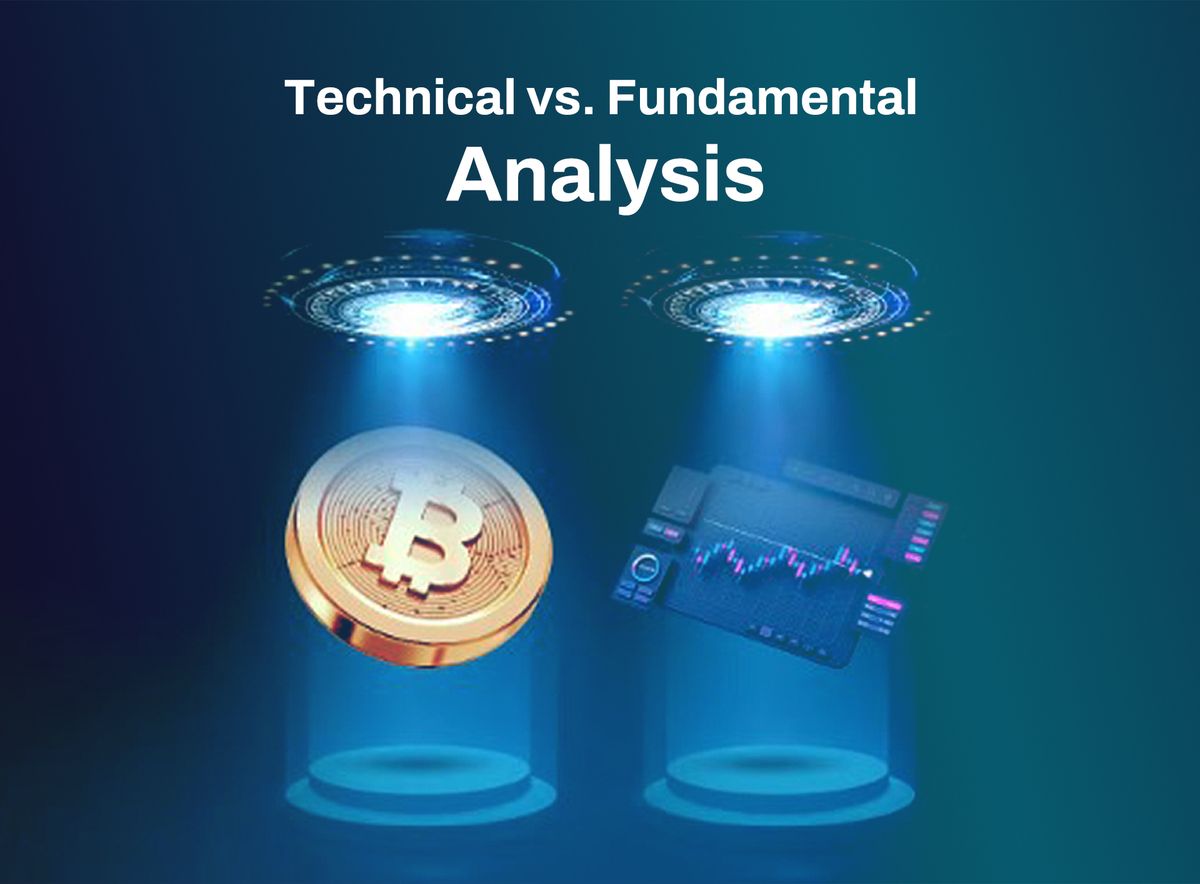Technical vs. Fundamental Analysis: Finding the Right Balance As a Crypto Trader
Learn how to strike the right balance between data-driven charts and real-world market factors to make smarter trading decisions.

TABLE OF CONTENTS:
1. Introduction
2. What is Technical Analysis?
3. What is Fundamental Analysis?
4. Key Differences Between Technical and Fundamental Analysis
5. The Role of Technical Analysis in Crypto Trading
6. The Role of Fundamental Analysis in Crypto Trading
7. Finding the Right Balance: Integrating Technical and Fundamental Analysis
8. Tools and Resources for Technical and Fundamental Analysis
9. Closing Thoughts
10. FAQs
What is Technical Analysis?
Technical analysis is a method traders use to predict the future price movements of assets, including cryptocurrencies like Bitcoin and Ethereum. It relies on studying historical price data and market statistics to identify patterns and trends that may repeat in the future.
Instead of focusing on the essential value of an asset, technical analysis looks at price charts and trading volumes to make predictions. For instance, they might use moving averages, which are like smooth lines on a chart that show average prices over a specific period, trying to spot patterns like upward trends, downward trends, or periods of stability.
Technical analysts use various tools and indicators, such as moving averages, support and resistance levels, and momentum oscillators, to help them interpret market behaviour. These indicators provide valuable insights into the market sentiment and help traders make informed decisions about buying, selling, or holding assets.
While technical analysis doesn't guarantee accurate predictions, it provides traders with valuable information to manage risks and identify potential opportunities in crypto trading. By understanding technical analysis, traders can better grasp market dynamics and improve their chances of success in the crypto markets.
What is Fundamental Analysis?
Fundamental analysis involves evaluating a cryptocurrency's underlying factors, such as its technology, team, use case, and market demand. Just like you'd check the foundation of a house before buying it, fundamental analysis helps you assess the strength and potential of a cryptocurrency.
If you're thinking of investing in a new coin – fundamental analysis would involve checking if the project has a solid purpose, a capable team, and if it addresses a real-world problem. Numbers matter too; you'd want to know things like the coin's total supply and its adoption rate. Let's say a coin has a limited supply, like Bitcoin with only 21 million coins – that scarcity can potentially drive up its value over time.
Fundamental analysis isn't about predicting short-term price movements; it's about understanding the long-term viability of a cryptocurrency. So, while technical analysis focuses on charts and patterns, fundamental analysis digs deeper into the substance of a cryptocurrency, helping you make more informed decisions in crypto trading.
Key Differences Between Technical and Fundamental Analysis
1. Focus and Methodology:
Technical Analysis:
Technical analysis focuses on analysing historical price data and trading volume to identify patterns and trends in the market. It relies heavily on charts and mathematical indicators to predict future price movements. Traders using technical analysis believe that historical price movements repeat themselves and can be used to predict future price directions.
Fundamental Analysis:
Fundamental analysis, on the other hand, explores the primary value of an asset by examining factors such as company financials, industry trends, economic indicators, and market sentiment. Fundamental analysts seek to determine whether an asset is overvalued or undervalued based on its underlying fundamentals. They believe that market prices eventually reflect the actual value of an asset.
2. Time Horizon:
Technical Analysis:
Technical analysis is typically used by short to medium-term traders who aim to profit from short-term price fluctuations. Traders using technical analysis may hold positions for minutes, hours, or days based on their analysis of chart patterns and market indicators.
Fundamental Analysis:
Fundamental analysis is often employed by long-term investors interested in an asset's underlying strength and growth potential over the long term. Fundamental analysis involves researching and evaluating a company or asset's financial health, competitive advantages, and growth prospects.
3. Data Used:
Technical Analysis:
Technical analysis primarily relies on quantitative data such as price and volume to make trading decisions. Charts, graphs, and mathematical formulas are used to identify patterns and trends in the market.
Fundamental Analysis:
Fundamental analysis utilises both quantitative and qualitative data to evaluate the primary value of an asset. This includes financial statements, earnings reports, industry trends, competitive analysis, and macroeconomic factors that may affect the asset's value.
4. Market Efficiency:
Technical Analysis:
Technical analysts believe that all relevant information about an asset is already reflected in its price movements. They argue that past price data can be used to predict future price movements, making markets relatively efficient.
Fundamental Analysis:
Fundamental analysts may believe that markets are not always efficient and that mispricing can occur due to factors such as investor sentiment or market irrationality. They believe that diligent analysis of fundamental factors can uncover opportunities where assets are mispriced relative to their primary value.
5. Adoption and Popularity:
Technical Analysis:
Traders across various financial markets, including stocks, forex, and cryptocurrencies, widely use technical analysis. Many trading platforms offer a wide range of technical analysis tools and indicators to assist traders in making informed decisions.
Fundamental Analysis:
Fundamental analysis is more commonly associated with traditional investing in stocks and bonds. However, it is also gaining popularity in the cryptocurrency market as investors seek to understand digital assets' underlying value and potential.
The Role of Technical Analysis in Crypto Trading
1. Understanding Price Patterns:
Technical analysis looks at patterns in the price movements of cryptocurrencies. By identifying recurring patterns, traders can make educated guesses about where prices might be headed. For instance, if a particular pattern historically led to a price increase, traders might expect a similar outcome if they spot that pattern again.
2. Identifying Trends:
One of the primary roles of technical analysis is identifying cryptocurrency price trends. By studying price charts, traders can spot patterns such as uptrends, downtrends, or sideways movements. Understanding these trends helps traders decide whether to buy, sell, or hold their crypto assets.
3. Support and Resistance Levels:
Technical analysis helps traders identify key support and resistance levels in the market. Support levels are price points where buying interest is strong enough to prevent the price from falling further, while resistance levels are price points where selling interest is strong enough to prevent the price from rising further. Recognising these levels can help traders set entry and exit points for their trades.
4. Chart Patterns:
Technical analysts pay close attention to chart patterns, such as triangles, flags, and head-and-shoulders formations. These patterns provide valuable insights into market sentiment and potential price movements. For example, a symmetrical triangle pattern may indicate strength before a breakout, while a head-and-shoulders pattern could signal a trend reversal.
5. Indicators and Oscillators:
Technical analysts use various indicators and oscillators to assess market momentum and strength. Common indicators include moving averages, Relative Strength Index (RSI), and Moving Average Convergence/Divergence (MACD). These tools help traders gauge whether a cryptocurrency is overbought or oversold, which can inform their trading decisions.
6. Risk Management:
Technical analysis plays a crucial role in risk management for crypto traders. By analysing historical price data and market trends, traders can identify potential risks and adjust their trading strategies accordingly. Techniques like setting stop-loss orders and position sizing help traders reduce losses and protect their capital.
7. Emotional Discipline:
Lastly, technical analysis promotes emotional discipline in trading. Instead of making impulsive decisions based on fear or greed, traders rely on objective data and analysis to guide their actions. This disciplined approach reduces the likelihood of emotional trading mistakes and improves overall trading performance.
The Role of Fundamental Analysis in Crypto Trading
1. Understanding the Project:
Fundamental analysis begins with a deep dive into the cryptocurrency project itself. What problem does it solve? How experienced is the development team? Is there a practical use case for the coin? By answering these questions, investors can gauge the viability and sustainability of the project.
2. Examining Market Demand:
Cryptocurrencies, like any other asset, are subject to market demand. Fundamental analysis looks at the real-world need for the cryptocurrency. Does it serve a purpose in the market? Analysing demand helps predict whether the cryptocurrency will have lasting value.
3. Assessing Partnerships and Collaborations:
The partnerships and collaborations a cryptocurrency forms can significantly impact its success. Fundamental analysis involves scrutinising the alliances a project has established. Strong partnerships with reputable companies enhance credibility and positively influence the coin's value.
4. Evaluating Technology and Security:
The underlying technology of a cryptocurrency is critical. Fundamental analysis assesses the technical aspects, including the blockchain technology, consensus mechanism, and security features. A secure and strong technology foundation contributes to the overall reliability of the cryptocurrency.
5. Analysing Tokenomics:
Tokenomics refers to the economic model of a cryptocurrency. Fundamental analysis looks into factors such as token distribution, supply limits, and incentives for holding the coin. Understanding tokenomics helps investors grasp how the cryptocurrency's value might evolve over time.
6. Considering Regulatory Environment:
Cryptocurrencies are influenced by regulatory developments. Fundamental analysis considers the legal and regulatory environment surrounding a cryptocurrency. Clear regulatory pathways can provide a sense of security for investors, while uncertainty may lead to volatility.
7. Examining Community and Social Sentiment:
The community backing a cryptocurrency is an essential factor. Fundamental analysis involves evaluating the level of community engagement and sentiment. A solid and supportive community can drive adoption and positively impact the coin's value.
Finding the Right Balance: Integrating Technical and Fundamental Analysis
Combining technical and fundamental analysis gives you the best of both worlds. You can identify promising cryptocurrencies with strong fundamentals and use technical analysis to effectively time your entry and exit points.
For example, you might spot a cryptocurrency with a solid team, innovative technology, and a growing community (fundamental analysis). Then, use technical indicators like moving averages and RSI to determine the best time to buy or sell (technical analysis).
To emphasise the importance of balance, let's look at some numbers.
In 2021, Bitcoin's price rose by over 300%, making it a hot topic in the financial world.
Technical analysis might have helped predict these price movements by analysing historical data and trends.
Meanwhile, fundamental analysis would have considered the growing acceptance of Bitcoin as a mainstream investment, with companies like Tesla and Square investing billions. So, the right balance involves looking at both the charts and the background story.
Statistics show that traders who combine technical and fundamental analysis tend to outperform those who rely solely on one approach.
According to a recent study, 78% of successful traders use a combination of both methods to inform their decisions. By diversifying your analytical tools and staying disciplined, you can increase your chances of success in crypto trading.
Common Pitfalls to Avoid
As a crypto trader using technical and/or fundamental analysis, steering clear of common pitfalls is necessary for a successful journey. Let's break down these pitfalls below:
1. Overreliance on Short-Term Trends:
It's tempting to get caught up in the excitement of short-term price movements. However, relying solely on these trends can be misleading. Cryptocurrency markets are unstable, and short-term fluctuations may not accurately reflect the underlying value of an asset. To avoid this pitfall, consider a balanced approach incorporating both short-term and long-term perspectives.
2. Ignoring Fundamental Factors:
Ignoring fundamental factors like the project's technology, team, and partnerships can lead to uninformed decisions. Remember, a solid foundation is crucial for long-term success in the crypto space.
3. Emotional Trading:
Emotional decision-making often leads to impulsive actions. Whether it's fear, greed, or FOMO (Fear of Missing Out), emotions can cloud judgment. Establishing a clear strategy and sticking to it, regardless of market fluctuations, helps avoid emotional pitfalls. Keep a level head and focus on the fundamentals and your trading plan.
4. Lack of Risk Management:
Crypto markets can be unpredictable, and losses are inevitable at times. Failing to implement proper risk management strategies can result in significant setbacks. Set realistic stop-loss levels, diversify your portfolio, and only invest what you can afford to lose. This disciplined approach minimises the impact of unfavourable market conditions.
5. Chasing Hype and Rumours:
Cryptocurrency markets are filled with hype and rumours that can influence prices in the short term. However, relying solely on such information can lead to misguided decisions. Verify information from reliable sources before making trading choices, avoiding falling into the trap of chasing unfounded hype.
6. Disregarding Market Sentiment:
Market sentiment, or the overall mood of traders, plays a role in price movements. Ignoring this factor can result in missed opportunities or unexpected downturns. Stay informed about market sentiment through social media, news, and community forums. It provides valuable insights into the collective mindset of the market participants.
Tools and Resources for Technical and Fundamental Analysis
Let’s look at some of the tools and resources used for both technical and fundamental analysis:
1. Technical Analysis Tools:
- Candlestick Charts:
Candlestick charts are like the heartbeat of market movements. They show the opening, closing, and high and low prices over a specific period. Green candles mean prices went up; red ones mean they went down. These charts help you spot trends and potential reversals, helping you decide when to buy or sell.
- Moving Averages:
Moving averages smooth out price data to create a single flowing line. They help you see the overall direction of an asset's price. When the price is above the moving average, it's generally an upward trend; when below, it might be a downtrend. This tool simplifies the market noise.
- Relative Strength Index (RSI):
RSI is like a cool calculator for crypto traders. It measures the speed and change of price movements. If RSI is high, it might mean the asset is overbought (too popular, maybe due for a dip), and if it's low, it might be oversold (less popular, possibly ready for a rise).
- MACD (Moving Average Convergence Divergence):
The Moving Average Convergence Divergence (MACD) helps crypto traders spot potential trend reversals in the market. When the MACD line crosses above the signal line, it signals a possible upward movement, and when it crosses below, it suggests a possible downward shift.
- Support and Resistance Levels:
Support is where prices often bounce back up, and resistance is where they struggle to go beyond. Knowing these levels helps you set entry and exit points, acting like a GPS for your trades.
2. Fundamental Analysis Resources:
- Market News:
Market news provides real-time updates on what's happening in the crypto world. Important news can cause prices to jump or drop, so staying informed is key. For example, if a country decides to regulate cryptocurrencies, it can significantly impact the market.
- Whitepapers:
Whitepapers are like the instruction manuals for cryptocurrencies. They explain the purpose, technology, and goals of a particular crypto. Reading a whitepaper is similar to studying the blueprint of a building before deciding to invest in its construction. It helps you understand the fundamentals and the potential of a crypto project.
- Tokenomics:
“Tokenomics” is just a fancy way of saying "how the token works." It is the economic system of a cryptocurrency or the rules that govern how a crypto operates. Understanding tokenomics helps us evaluate the long-term viability of a cryptocurrency. For instance, if a crypto has a limited supply, it may become more valuable over time due to scarcity.
- Social Media:
Social media is the town square for crypto enthusiasts. X (formerly Twitter), Reddit, and other platforms are where people discuss and share their thoughts on different cryptocurrencies. Monitoring social media helps you evaluate the sentiment around a cryptocurrency – whether people are excited, sceptical, or indifferent.
- Team and Partnerships:
Checking the background of the team and partnerships is very important in fundamental analysis. Their reputation, ethics, and vision reflect on the cryptocurrency.
Closing Thoughts
In conclusion, finding the right balance between technical and fundamental analysis is the key to becoming a successful crypto trader.
Just like a skilled chef combines various ingredients to create a masterpiece, integrating these analytical approaches can lead to well-informed and profitable decisions in the “exciting” world of crypto trading.
FAQs
Q1. Can I be successful with only one type of analysis?
A1. While possible, combining both technical and fundamental analysis tends to provide a more comprehensive view.
Q2. How do I start with technical analysis?
A2. Begin by learning basic chart patterns and indicators. Practice with historical data before applying it to real-time trading.
Q3. What's the best timeframe for technical analysis?
A3. It depends on your trading style. Short-term traders may focus on hourly charts, while long-term investors may prefer daily or weekly charts.
Q4. What factors are crucial in fundamental analysis?
A4. Consider the project's technology, team experience, partnerships, market demand, and competition.
Q5. Is cryptocurrency trading only for experts?
A5. No, but it requires education, research, and a disciplined approach. Start small, learn continuously, and manage risks.
Q6. How often should I update my analyses?
A6. Regularly review your analyses based on market changes, project updates, and new information.
Q7. Can technical analysis predict market crashes?
A7. It can help identify potential downturns, but it's not foolproof. Combine it with risk management strategies.
Q8. Is fundamental analysis relevant for short-term trading?
A8. Yes, understanding a project's fundamentals can help make informed short-term trading decisions.
Q9. Should I prioritise quantity or quality in my cryptocurrency portfolio?
A9. A balanced approach is key. Quality ensures long-term growth, while quantity helps manage risk.
Q10. Can I rely on automated tools for analysis?
A10. Automated tools can assist, but it's crucial to understand the underlying principles of both technical and fundamental analysis.
Disclaimer: This article was written by the writer to provide guidance and understanding of cryptocurrency trading. It is not an exhaustive article and should not be taken as financial advice. Obiex will not be held liable for your investment decisions.




